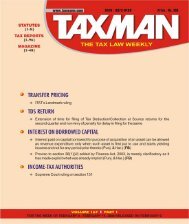CPT V24P7-Art1 (Content).pmd - Taxmann
CPT V24P7-Art1 (Content).pmd - Taxmann
CPT V24P7-Art1 (Content).pmd - Taxmann
You also want an ePaper? Increase the reach of your titles
YUMPU automatically turns print PDFs into web optimized ePapers that Google loves.
As per section 145 of the IT Act business<br />
income is required to be computed in accordance<br />
with the cash or mercantile system of accounting.<br />
Sub-section (2) thereof authorizes the Central<br />
Government to notify in the Official Gazette<br />
from time-to-time Accounting Standards to be<br />
followed by any class of assessees or in respect<br />
of any class of income. Sub-section (3A) requires<br />
that the profit and loss account and balancesheet<br />
should be prepared according to Accounting<br />
Standards. Sub-section (3C) defines “Accounting<br />
Standards”. A combined effect of these provisions<br />
of the Act and the Companies Act, 1956 is that<br />
the assessees, which are companies showing<br />
income under the head “Business or profession”,<br />
have to follow the Accounting Standards<br />
prescribed. The Government of India has notified<br />
Accounting Standards in exercise of its powers<br />
under section 145(2) of the Act. (RE: CIT v.<br />
Dinesh Kumar Goel [2011] 197 Taxman 375 (Delhi)).<br />
The Accounting Standards are intended to be<br />
in conformity with the law, but if conflict<br />
arises due to subsequent amendment, in law,<br />
then the provision of law will prevail. But if<br />
there is no conflict, AS is to be followed and<br />
applied for recognizing revenue and liabilities.<br />
Prior to issue of Accounting Standards by ICAI<br />
guidance notes on accounting of leases were<br />
issued for the first time in 1988 which were<br />
revised in 1995. About the importance of guidance<br />
notes issued by the ICAI, Hon'ble Delhi High<br />
Court in CIT v. Virtual Soft Systems Ltd. [2012]<br />
205 Taxman 257/18 taxmann.com 119 observed<br />
that “the guidance notes reflect the best practices<br />
adopted by accountants the world over” and<br />
further, that “as long as there was a disclosure<br />
of the change in the accounting policy in the<br />
accounts which had a backing of a professional<br />
body such as ICAI, it could not be discarded<br />
by the A.O.”<br />
In this context, it would be appropriate to<br />
refer to para 11 of “Guidance Notes on<br />
Accounting for Leases as revised in 1995”. It<br />
says in respect of lessors as follows:<br />
“It is appropriate that against the lease<br />
rental, a matching lease annual charge is<br />
made to the profit and loss account. This<br />
annual lease charge should represent<br />
recovery of the net investment/fair value<br />
of the leased asset over the lease term.<br />
The said charge should be calculated by<br />
deducting the finance income for the period<br />
(as per para 12 below) from the lease<br />
rental for that period. This annual lease<br />
charge would comprise: (i) minimum<br />
statutory depreciation, (e.g., as per the<br />
Companies Act, 1956) and (ii) lease<br />
equalization charge, where the annual lease<br />
charge is more than the minimum statutory<br />
depreciation. However, where annual lease<br />
charge is less than minimum statutory<br />
depreciation, a lease equalization credit<br />
would arise. In this regard the following<br />
accounting entries/disclosures should be<br />
made:—<br />
(a) A separate Lease Equalization Account<br />
should be opened with a corresponding<br />
debit or credit to Lease<br />
Adjustment Account, as the case may<br />
be.<br />
(b) Lease Equalization Account should<br />
be transferred every year to the Profit<br />
and Loss Account and disclosed separately<br />
as a deduction from/addition<br />
to gross value of lease rentals shown<br />
under the head “Gross Income”.<br />
(c) Statutory depreciation should be<br />
shown separately in the profit and<br />
loss account. Accumulated statutory<br />
depreciation should be deducted from<br />
the original cost of the leased asset<br />
in the balance sheet of the lessor to<br />
arrive at the net book value.<br />
(d) Balance standing in Lease Adjustment<br />
Account should be adjusted in<br />
the net book value of the leased assets.<br />
The amount of adjustment in respect<br />
of each class of fixed assets may be<br />
shown either in the main balance<br />
sheet or in the Fixed Assets Schedule<br />
as a separate column in the section<br />
related to leased assets.<br />
August 1 to 15, 2012 u TAXMANN’S CORPORATE PROFESSIONALS TODAY u Vol. 24 u 59<br />
679











![“FORM NO. 3CEB [See rule 10E] Report from an ... - Taxmann](https://img.yumpu.com/45480232/1/190x245/form-no-3ceb-see-rule-10e-report-from-an-taxmann.jpg?quality=85)





